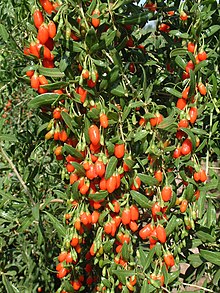
Back Lycium barbarum Afrikaans عوسج Arabic عوسج ARZ Lycium barbarum AST Adi itiüzümü Azerbaijani འཕང་འབྲས། Tibetan Arç negre Catalan Lycium barbarum CEB Lycium barbarum Corsican Kustovnice cizí Czech
| Lycium barbarum | |
|---|---|

| |
| Lycium barbarum with ripe berries | |
| Scientific classification | |
| Kingdom: | Plantae |
| Clade: | Tracheophytes |
| Clade: | Angiosperms |
| Clade: | Eudicots |
| Clade: | Asterids |
| Order: | Solanales |
| Family: | Solanaceae |
| Genus: | Lycium |
| Species: | L. barbarum
|
| Binomial name | |
| Lycium barbarum | |
| Synonyms[1] | |
| |
Lycium barbarum is a shrub native to China,[2][3][4] with present-day range across Asia and southeast Europe.[5] It is one of two species of boxthorn in the family Solanaceae from which the goji berry or wolfberry is harvested, the other being Lycium chinense.
Common names of the plant in English include Chinese wolfberry,[2] barbary matrimony vine,[2] red medlar[6] or matrimony vine.[2] In the United Kingdom it is also known as Duke of Argyll's tea tree after Archibald Campbell, 3rd Duke of Argyll who introduced it in the country in the 1730s.[2]
The shrub is an important commercial crop in northern China, especially in the Ningxia Hui Autonomous Region. Its Chinese name is Ningxia gǒuqǐ.
- ^ "The Plant List".
- ^ a b c d e "Lycium barbarum". Germplasm Resources Information Network. Agricultural Research Service, United States Department of Agriculture. Retrieved 22 December 2017.
- ^ Cite error: The named reference
aussie2was invoked but never defined (see the help page). - ^ Cite error: The named reference
florawebwas invoked but never defined (see the help page). - ^ Flint, Harrison Leigh (1997). "Lycium barbarum". Landscape plants for eastern North America: exclusive of Florida and the immediate Gulf Coast. Chichester: John Wiley & Sons. p. 326. ISBN 978-0-471-59919-7.
- ^ McAdam, Diana (12 October 2007). "Goji berries: The new superfruit". The Telegraph, Telegraph Media Group Limited, London, UK.